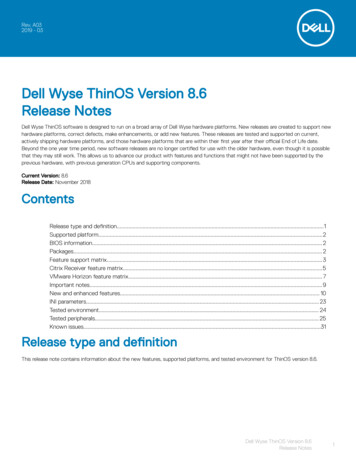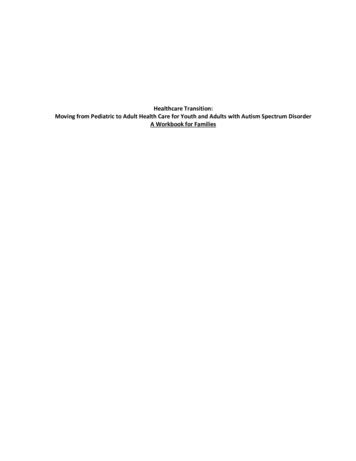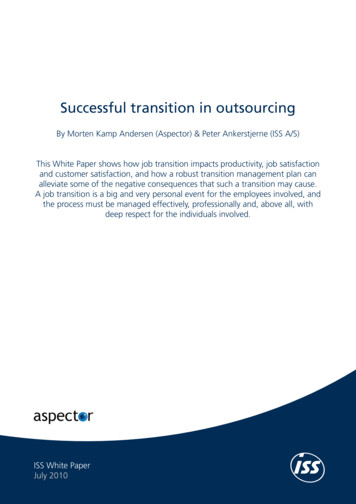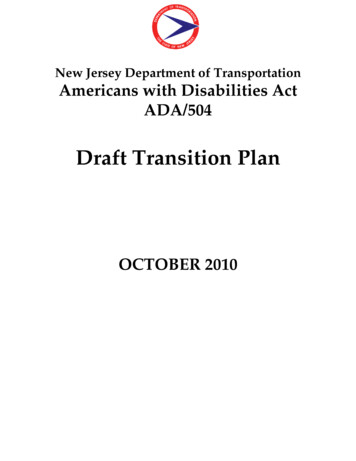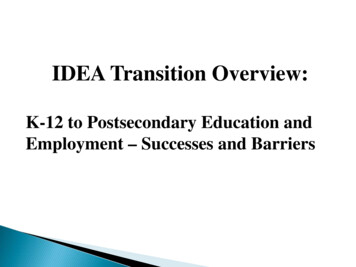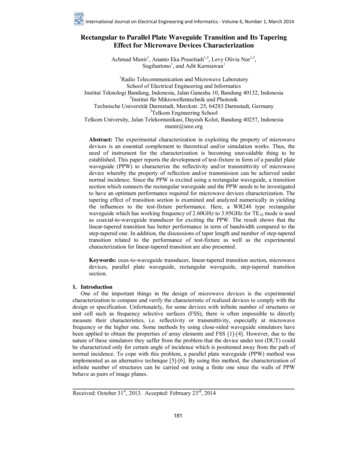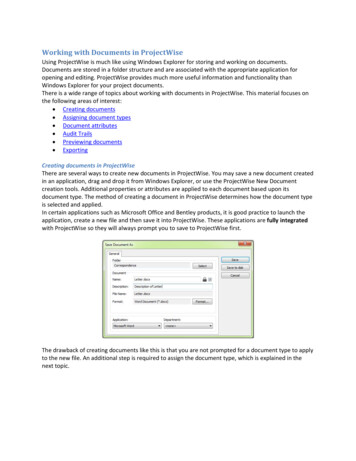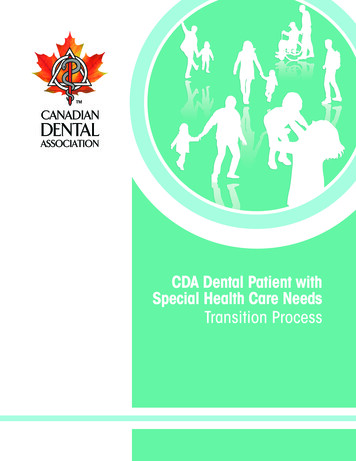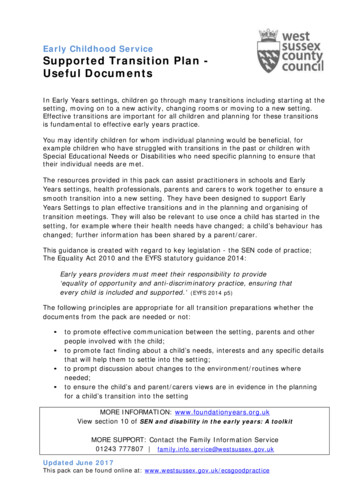
Transcription
Early Childhood ServiceSupported Transition Plan Useful DocumentsIn Early Years settings, children go through many transitions including starting at thesetting, moving on to a new activity, changing rooms or moving to a new setting.Effective transitions are important for all children and planning for these transitionsis fundamental to effective early years practice.You may identify children for whom individual planning would be beneficial, forexample children who have struggled with transitions in the past or children withSpecial Educational Needs or Disabilities who need specific planning to ensure thattheir individual needs are met.The resources provided in this pack can assist practitioners in schools and EarlyYears settings, health professionals, parents and carers to work together to ensure asmooth transition into a new setting. They have been designed to support EarlyYears Settings to plan effective transitions and in the planning and organising oftransition meetings. They will also be relevant to use once a child has started in thesetting, for example where their health needs have changed; a child’s behaviour haschanged; further information has been shared by a parent/carer.This guidance is created with regard to key legislation - the SEN code of practice;The Equality Act 2010 and the EYFS statutory guidance 2014:Early years providers must meet their responsibility to provide‘equality of opportunity and anti-discriminatory practice, ensuring thatevery child is included and supported.’ (EYFS 2014 p5)The following principles are appropriate for all transition preparations whether thedocuments from the pack are needed or not: to promote effective communication between the setting, parents and otherpeople involved with the child;to promote fact finding about a child’s needs, interests and any specific detailsthat will help them to settle into the setting;to prompt discussion about changes to the environment/routines whereneeded;to ensure the child’s and parent/carers views are in evidence in the planningfor a child’s transition into the settingMORE INFORMATION: www.foundationyears.org.ukView section 10 of SEN and disability in the early years: A toolkitMORE SUPPORT: Contact the Family Information Service01243 777807 family.info.service@westsussex.gov.ukUpdated June 2017This pack can be found online at: www.westsussex.gov.uk/ecsgoodpractice
CONTENTSThese documents are intended as guidance for practitioners, other versions can also be usedDOCUMENT:USE:Universal transition guidanceAims, and key elements of good transition practiceMulti-agency recordRecord details of professionals involved with/or supporting thechild, for example, Portage, Early Support Coordinator,Physiotherapist, Speech and Language Therapist, SensorySupport Team, Paediatrician, Occupational Therapist, FamilyOutreach Worker etcOne Page Profile(with or without border)Format to capture and communicate the important informationabout a child who needs additional planning and supportLetter to arrangetransition meetingTemplateHealthcare Plan(this is not a statutory Education,Health and Care Plan)Proforma to record information about a child’s health needs, forexample, to notify staff about procedures to follow, strategies touse etc. It is intended to be used to record health informationshared by the parent/carer with the setting, please advise theparent/carer to ask a health professional (who knows the child),to verify and sign the plan. This will help parent/carers to feelconfident that consistent practices will be used in the settingEXAMPLEExample Healthcare PlanAdministration of medicationconsent formTemplate parental consent formRisk Management PlanThis document supports practitioners to manage a discussion withparents/carers to minimise or eradicate risks for the child orothers within the setting environmentEXAMPLEExample Risk Management PlanAccessibility AuditTool to help practitioners review their setting environment andtake actions to make necessary adjustments where neededAccessibility DevelopmentPlanCreate a plan following the audit
Universal transition guidanceThe following guidance and supporting documentation was co-produced by the EarlyChildhood Service and Education and Skills, in consultation with colleagues fromschools and the wider early years and childcare workforce. It has been developed tobuild on existing good practice and to ensure that all children in the Foundation Stagehave access to a transition based on best practice.The aim of this guidance is To establish a coherent county wide transition procedure for allchildren in the early years, including those with specialeducational needs and disabilities.To provide children, parents, teachers and practitioners with tools andmaterials to support this process.In the early years, children go through many transitions including starting at asetting for the first time, moving on to a new activity, moving between rooms, ormoving to a new setting or school.Effective transitions are important for children’s emotional wellbeing andachievement, and planning for these transitions is fundamental to effective earlyyears practice.To ensure continuity of experience for children, transition should be seen as aprocess rather than as a one off event. Discussions involving the child, parentsand others throughout the planning process will support successful transitions.The following principles are appropriate for all transitions: effective communication between the setting, parents and other peopleinvolved with the child;fact finding about a child’s needs, including the involvement of any otheragencies, their interests and any specific details that will help them tosettle ;discussion about changes to the environment/routines that may beneeded;the child’s and parent/carers views are central to and in evidence in theplanning for a child’s transition
Key elements of good transition practiceThe following prompts will help you to reflect on your owntransition practice Transition is made a priorityTransition should be seen as an ongoing process throughout the year.Key information should be shared prior to the child starting in the setting.See Appendix for Transition Summary document and Transition EventRecordChildren are familiar with the people, places and routinesDo children have opportunities to visit their new environment? Are parentsencouraged to meet up and socialise in the long summer break beforestarting school? Do you provide children with photos/books/DVDs showingkey staff, spaces and routines?Children can make frequent visits to the settingAre they able to visit with parents, grandparents or key people from theirexisting setting?Children receive a home visitAre you able to offer families a visit in their home environment? Theseshould take place as close to the child’s start date as possibleFamilies have an allocated Key PersonRelationships with a consistent member of staff are crucial to childrensettling well and building trusting relationships with both parents andchildren. How does this person maintain ongoing dialogue and informationsharing with parents and carers?Parents are involved, consulted and supportedHow does your setting gather, value and respond to the information,hopes and concerns of families? What is in place to ensure that thisinformation sharing continues once the child has started?There is an informal and relaxed start and finish to the sessionAre parents encouraged to come in at the start of the session? Arechildren able to self-select activities as they arise? Do parents feelwelcome? Can they stay and help settle their child?Children’s friendships are acknowledgedConsider how your groupings support children’s existing friendshipsThe setting is flexible in meeting individual needsHow do you support children’s individual feeding, sleeping and toiletingneeds? How are you able to support their current interests and schemas?Children and families requiring a supported transition areidentified and planned for as early as possible.How do you identify, plan for and meet the needs of children withadditional needs? Do you ensure that the hopes and wishes of the familyare reflected in your planning? Are you aware of any other agenciesworking with the child or family? How will you involve these professionalsin transitioning planning? Is any specialist equipment or training needed?
See Supported Transition Plan and GuidanceSchools/settings should consider to what extent theirpolicies and procedures ensure the following Let parents know what kind of information you will need to help their childto settle;Make it clear who is responsible for gathering information about a childand who will need to contact other professionals for more information;Request parental consent to share information between professionals;Address where there is a gap between allocation of a place and start date,and ask for an update on the child’s learning, well-being and developmentto ensure you have all the information you need to plan for a successfultransition.This transition documentation is intended as guidance only. It does not present adefinitive model of transition rather it presents examples of good practice thatcan assist with your current policy and procedures.
Multi – Agency RecordUse this record to document who is involved in supporting your child, please share this with the setting. Your child may haveappointments with a number of different professionals, sometimes they will provide advice that is helpful in ensuring yourchild’s needs are met in our setting.It would be helpful to us and any visiting professionals if you could provide the information requested below.(N.B. If parents are using the Early Support Family File, they may prefer to provide a copy of this, rather than completing theform below)Name of child:DateReferral made/Appointmentreceived/Seen by (Name)Signature of parent/carerAgency & Phone no.(e.g. speech and languagetherapist, health visitor,paediatrician, specialist healthvisitor, Family OutreachWorker)Comments(Parent, professional or setting maywish to add comments)Copy ofReport /Advicediscussed withan Early Yearsand ChildcareAdvisor( if applicableand date)
I give permission for this information to be shared with next school/setting at point of transition.Signed:(Parent/Carer)(N.B. Parents/carers may prefer to consider this permission at the point of transition)
Photo of mePage 6
Photo of mePage 7
SAMPLE LETTER TO ARRANGE A TRANSITION MEETINGContact details:For the attention of: the SENCO/INCO and key person or Reception Teacher / EYFS co-ordinatorDate:Dear We would like the opportunity to meet and discuss transition plans forName . D.O.B who will be transferring from . to next term.I would be grateful if you could contact me as soon as possible so that wecan arrange a mutually convenient time and venue to hold a supportedtransition meeting. We will invite the parent/carers to this meeting.Yours sincerely(Sign and state position, for example INCO/ SENCO / MANAGER/receptionteacher)
HEALTHCARE PLANThis is to help you to plan to support a child’s health care needs, and is not astatutory Education, Health and Care Plan.SETTING:CHILD’SPHOTOCHILD’S NAME:Date of birth:Date of plan:Review date:CONTACT INFORMATION1st Family ContactName:2nd Family ContactName:Phone No:Phone No:Home:Home:Work:Work:Mobile:Mobile:Relationship to child:Relationship to child:Clinic/hospital contactName:Phone number:Clinic/hospital:G.P.Name:Phone number:Surgery:If medication is required a copy of the prescription or health professional’s letterregarding administration details of any medication should be attached to this form.
MY HEALTH OR MEDICAL NEEDS ARE MY DAILY CARE NEEDS ARE IT IS AN EMERGENCY IF THIS HAPPENS IN AN EMERGENCY PLEASE DO THE FOLLOWING WHO IS RESPONSIBLE?MY FOLLOW UP CARE NEEDS ARE SIGNED:PARENT/CARERSETTING:Name and signature of child’s healthcare practitioner to verify these details are correct:PIN:
HEALTHCARE PLAN (example)This is to help you to plan to support a child’s health care needs, and is not astatutory Education, Health and Care Plan.SETTING:Anytown pre-schoolCHILD’S NAME:CHILD’SPHOTOAnn OtherDate of birth:12.03.12Date of plan:01.05.15Review date:01.11.15CONTACT INFORMATION1st Family ContactName: Belinda Other2nd Family ContactName: Nina OtherPhone NoPhone NoHome: 01243 123456Home: 01243 789101Work: 01243 654321Work:Mobile: 07788 234567Relationship to child: mothern/aMobile: 07799 345678Relationship to child: grandmotherClinic/hospital contactName:Mr. V. NicePhone number: 01243 777889Clinic/hospital: Anytown General HospitalG.P.Name:Dr. V GoodPhone number: 01243 666223Surgery:Anytown Health CentreIf medication is required a copy of the prescription or health professional’s letterregarding administration details of any medication should be attached to this form.
MY HEALTH OR MEDICAL NEEDS ARE I have epilepsy. I experience frequent ‘absences’ and occasional tonic clonic seizures.MY DAILY CARE NEEDS ARE Anti-epileptic medication taken morning and night at home. Buckle diazelam requiredafter tonic clonic seizure.IT IS AN EMERGENCY IF THIS HAPPENS I fall to the ground – tonic clonic seizure. I may shake.IN AN EMERGENCY PLEASE DO THE FOLLOWING WHO IS RESPONSIBLE?Move any furniture/objects on which I might hurt myself.Put a cushion under my head.Stay with me and wait for the seizure to pass.Call an ambulance and my parents.MY FOLLOW UP CARE NEEDS ARE After the seizure, turn me to lie on my side.Talk to me calmly and quietly.Administer rectal diazepam.SIGNED:PARENT/CARER:Belinda OtherSETTING:Carlie ClearlyDate:01.05.15Name and signature of child’s healthcare practitioner to verify these details are correct:Date: 10.06.15Vernon NiceVernon NicePIN:543210Please note: this is an example format to help you complete the form and should not be used asmedical information for a child in your setting.
ADMINISTRATION OF MEDICATION - PARENTAL CONSENT FORMName of setting:Child’s name:Date of birth:1. As a parent/carer with parental responsibility for the above named child, I confirm thatthey require the following medication.MedicationTime GivenAmountHow given2. I give permission for the person/s named below to hold the medicines andassist/supervise my child to take them as detailed above.3. I undertake to notify the setting in writing of any changes in medication.3. In giving this permission I accept full responsibility for my child’s welfare.Name and signature:Date:Relationship to the child:For completion by the practitioner1. I agree to hold the medication and assist/supervise the above-named child to take themas detailed above.2. I agree to keep a written record of medication given.Name and signature:DateOriginal to be kept on child’s file, copy to parents.Please note: Providers must keep a written record each time a medicine is administered to a child, andinform the child’s parents and/or carers on the same day, or as soon as reasonably practicable. (SeeStatutory Framework for the Early Years 2017 - sections 3.45 and 3.46)
Risk Management PlanDate of assessment:Setting:Child’s Name:DoB:Is there a Healthcare Plan?Yes / NoOther Relevant informationActivityRoutineRisk including risks tostaff/other childrenPotential benefits to the child ofthis activityViews of child, parent, practitioner,health professionalsActions to be taken to reduce risk if risk occurs
Date plan agreed:Plan agreed by:(Parent/carer)(Setting staff)Review date:(Not more than 6 months ahead)
Risk Management Plan (example)Date of assessment:Child’s Name:Setting: Littletown pre-school05.03.15James WinterIs there a Healthcare Plan?DoB: 26.03.12Yes / NoOther Relevant information: James is a very active child who enjoys climbing and balancing; he needs support to be aware of hisown safety and that of others. At home he attempts to climb up the door, back of the sofa, kitchen worktops etc. James uses someverbal sounds to communicate his needs and is beginning to respond to simple language (advised at speech and language drop-in) –Mum and Dad are also working on using natural gesture and Makaton signs to redirect his interests to safe activities. Parents havewalked around the setting with the key person to help assess risks.ActivityRoutineClimbingactivityRisk including risks tostaff/other children Falling fromequipment andfurniture andinjuring himself. Other childrenbeing injuredPotential benefits to the child ofthis activity James’ interestswill be supported. James will haveopportunities todevelop his grossmotor skills. James will besupported indeveloping hisawareness of hisown safety andthat of others.Views of child, parent, practitioner,health professionals James’ parents appreciatehis love of climbing andwould like him to besupported with hisinterests. OT stressed to parentsJames’ limitedunderstanding of risk andthe importance ofstrategies to support him.Jo (James’ key person)noted some of his interestsat the pre-entry visits andreassured parents that thisrisk management plan willensure everyone will knowActions to be taken to reduce risk if risk occurs Share clear support strategies fromJames’ individual plan with all adults Adult situated near the climbingequipment to support all children,including James, where needed insideand outside All adults to be responsible formonitoring James’ play interests andredirect to climbing equipment if heattempts to climb on furniture – usesimple language, picture prompts andMakaton signing (Jo to create visualchoice prompts of a small range ofactivities, for adults to have on keyrings for easy use) All adults will be alert to James’ nonverbal communication Adults offer simple verbal prompts and
how to support his safetythrough the play andlearning experiences. Arrival anddepartureof childrenandparentsRisk of Jamesleaving the buildingwhen the door isopenJames is supportedthrough this regularpart of daily routinefor children andfamilies.Planned variedopportunities for climbinginside and out will enablepractitioners to re-directJames from unsafeclimbing.James’ parents need to knowthat he is safe at all times inthe pre-school.gesture to support understandingwhen on climbing equipment e.g.‘James, hand here’ ‘James, sit down’(at top of slide) ‘James, look’ (to checkif safe to slide) then ‘ready,steady go!’ Adults will follow first aid procedures ifan accident occurs Key staff to attend training onsupporting children’s physicaldevelopment. A named adult to support James’ playduring arrival and departure times andredirect his attention to play activities. All practitioners are aware of andadhere to pre-school policy statingthat no member of staff would let achild leave building without theirknown adult. The practitioners managing the doorwill redirect queries/messages toanother practitioner in the room toensure attention is on the safety of thechildren at all times Manager to ensure that measures arein place to keep the environmentsecure, with particular reference toprocedures when visitors are admittedto or are leaving the premises.Date plan agreed: 05.03.15Plan agreed by:Review date:B Winter(Parent/carer)K. Black (INCO) J. White (key person)(Setting staff)13.07.15(Not more than 6 months ahead)
Accessibility AuditPhysical Accessibility AuditUnder each heading, have you considered children’s visual and auditory needs and the comprehension levelsaccessibility and children’s mobility and physical skillsCar parking andExternal FeaturesProximity / designated spaces?Current provision(what do we do/havenow?)Any further action/developments?Yes / No and actionPriorityHigh/medium/ lowSurface –( even, non-slip)Gradient –(not exceeding 1:20)Clear routesHazards – can any be removed?Entrance– are there steps?– kerbs (ridged)– ramps (non-slip/handrails)Visual, auditory and tactile info.Door clearly distinguishable?126/08/2015
EntranceSpaceCurrent provision(what do we do/havenow?)Any further action/developments?Yes / No and actionPriorityHigh/medium/ lowVisual, auditory and tactile info.Indoor EnvironmentCirculation spaceAccess to workshop areasFloor surface (non-slip/nonreflective), cushioned and carpetedareas.Good lighting – (The room is welllit but with blinds to prevent brightsunlight on children’s faces.)Adaptable lighting conditions(curtains / blinds etc.)Suitable Acoustics(e.g. soft furnishings- sufficient todampen background noise levelse.g. carpeting, curtains, cushions,drapes etc./ lowered ceilings)Symbols & Signs – visual / tactile226/08/2015
Changes of level? – distinguishedCurrent provision(what do we do/havenow?)Any further action/developments?Yes / No and actionPriorityHigh/medium/ lowAdjustable table heightsAdjustable height sand/watertraysInsert tables(to enable wheelchair access)Storage of toys and equipment isorganised and labelled with bothpictures and text.Sufficient internalstorage for wheelchair etc. (N.B.anticipatory duty of DDA)Internal StairsClearly markedConsistent sizeStair lift?Evacu chair?Lift?(is lift suitable for evacuation –is alternative needed)326/08/2015
Internal DoorsCurrent provision(what do we do/havenow?)Any further action/developments?Yes / No and actionPriorityHigh/medium/ lowClearly visible?Handles clearClosures suitable?ToiletsFully accessibleDoor opens and closes easily(easy to use lock)Large, clear floor space(free from obstacles).Hand rails (child and adult)Nappy changing areaPrivacyFittings and fixtures areaccessible to alle.g. loo roll, flush, wash bowl,soap dispenser, towels.426/08/2015
Communication AuditHave you considered children’s visual and auditory needs and the comprehension levelsClearly labelled (picture / tactileelement) equipmentCurrent provision(what do we do/havenow?)Any further action /developments?Yes / NoPriorityHigh/medium/ lowLarge print / recorded versions ofkey documentsN.B. RNIB website has informationabout the standards of large printhttp://www.rnib.org.uk/Visual / auditory alarm signalSignage – large print / tactileelementDisplays– large print / tactileelement, right height for children’seye level.Instructions – short with visualcues (gestures / objects etc.)526/08/2015
Language – simple / commentary/positive / inclusiveCurrent provision(what do we do/havenow?)Any further action/developments?Yes / No and actionPriorityHigh/medium/ lowRange of communication systemsExtensive use of gesture,alongside speechRange of prompts to warn ofchange of activity (visual /auditory)Use of visual material in carpettimes (e.g. story sacks / puppets)Visual timetable available andused throughout the session(see visual timetable leaflet)Visual sequences used (see visualstrategies leaflet)Range of books supports differentneeds – e.g. tactile / audio / clothand board books etc. (seeappended book audit)Photos are used to share (recent)past activities with children andparents626/08/2015
The nursery environment hasclearly defined workshop and playareas, which encourageinteraction e.g. low screens,shelvingCurrent provision(what do we do/havenow?)Any further action/developments?Yes / No and actionPriorityHigh/medium/ lowPlay areas and tables and seatingallow children to play face-to-face,as well as alongsideAll staff have opportunities toattend training and developpractice in supporting children’sCommunication, Language andLiteracy developmentPrivate ‘communication spaces’ forexample, dens and cubbies, areavailable726/08/2015
Appendix1 : Audit of Book AreaTotalnumberCloth booksBoard booksFlap booksSensory books e.g.touch, sound etcRhythm and rhymebooksAudio booksBooks that focus onfeelings andemotions(fiction/non-fiction)Books with thingsto moveHomemade booksincluding those thatuse photos of thechildrenBooks with positivemessage thatdifferent skills areof equal valueBooks with positiveimages of disabledchildren/adultsNumber currentlyaccessible tochildrenOf the total, notehow many in eachconditionGoodPoorComments/Actions826/08/2015
Routines and Experiences AuditHave you considered The wide range of impairments that children may have and how potential barriers can be removedFlexible routines are providedCurrent provision(what do we do/have now?)Any further action/developments?Yes / No and actionPriorityHigh/medium/ lowVisual / auditory prompts forchange of activity (includingprompts to pre-warn of change)Routines and experiences thattake account of the developmentalstages of the childrenAppropriate Planning for everychild based on the child’sdevelopmental stage and interestsChoice is planned forStaff look for underlying cause ofbehavioursTrips and special events areinclusiveQuiet areas and areas for physicalplay are available indoors and out926/08/2015
Accessible resources / storage(different heights)Sand / water trays at differentheightsRange of sensory equipment /experiences(see suggestions from DDA coursenotes – included in appendix 2 atbottom of this section of audit)There are sufficient materials andequipment to avoid waiting,frustration and conflictsSand timers available to supportautonomy and turn-takingToys / games include varioussensory features (see appendix 2)Variety of wheeled toys (seeappendix 2)Creative area equipment includesrange of sizes / thicknesses (seeappendix 2)Range of scissors availableMusical instruments presented indifferent ways (see appendix 2)1026/08/2015
Range of resources for throwing /catching (see appendix 2)Current provision(what do we do/have now?)Any further action/developments?Yes / No and actionPriorityHigh/medium/ lowActivities that promotecollaboration, as well as individualachievement, are planned for, forexample, joint wall displays, turntaking activities, floor puzzles,see-saw, parachuteThe setting has a quiet feelingsand emotions area that childrencan choose to go to withA range of resources to supportfeelings and emotions is availableeg feelings basket etc.Natural materials feature stronglyin the setting alongside manmade toys and equipment1126/08/2015
Appendix 2(from DDA course notes)Making activities inclusiveThe list below is not exhaustive but is intended to provide a starting point for developing inclusive experiences in early yearsand childcare settings. It is important that wherever possible, experiences offered indoors are mirrored in the outdoorenvironment. This supports us in meeting the individual learning styles and preferences of all children.Please also refer to the leaflet ‘Inclusive Environments’.The Environment (indoor and outdoor) Workshop / zoned areas providing a wide range of resources and experiences across the six areas of learningAlways provide new resources and experiences in addition to familiar onesAreas for quiet and solitude as well as opportunities for more boisterous playResources at different heights, including on the floorSand and water trays that can be used on the ground as well as on a standAdjustable height tablesArrange furniture to there is plenty of space to move aroundSymbols and pictures on doors to indicate equipment or activitiesClose cupboard doors and keep passage ways clear of clutterModel and encourage children to tidy resources throughout the sessionConsider ways of adjusting light within the environment. (The space should be well lit but avoid bright light and glare).Improve acoustics using soft furnishingsEnsure experiences are multi-sensory:Sound – wind chimes, plants and feeders to encourage birds, grasses and other plants that rustle, fountain or runningwater, musical instruments, treasure baskets, sound wall/fence, sensory bottlesTouch – different surfaces to walk/ride on, plants with furry leaves, pinecones, non-poisonous berries, variety of fabrics,toys and resources made from a range of materials (not just plastic!), treasure baskets, feely bags/boxes, range of materialsfor tactile play (e.g. sand, rice, bark chips, ‘gloop’, shaving foam, soap flakesSmell – pots with herbs, scented flowers and leaves, sensory bottles / socks, playdoh with various aromas, scented toys,cooking experiences1226/08/2015
Taste – kitchen garden with fruit, vegetables and herbs, cooking experiences, opportunity to try new foods including atsnack/meal times,Sight – flowers planted for good contrast, shiny mobiles (e.g. CDs), light and shadow boxes, colour paddles, bubble tubes,blowing bubbles, ribbons, coloured cellophane, magnifying glasses, torches, sensory bottles, mirrorsProprioception – a range of resources that help children familiarise with their body position, balance and movement indifferent spaces e.g. pulling/pushing carts outside, space hoppers, trampoline, ‘wobble’ board, balance beams, seesaw, giantcones, monkey bars, swings, see-saw.ResourcesToys and large activity equipment Fixed Ensure a range of toys are accessible and stable for use such as anchoring to table or builders’ trayReplace small knobs on inset boards and puzzles with larger knobs or plastic golf teesMake games which reflect children’s experiences, eg transport matching games can include wheelchairsMake matching games using textures, shapes or smells instead of picturesMake simple sound lotto gamesMake feely-bag gamesWheeled toys such as:Trundle toys with and without pedalsPush-along toysCarts that can be towedHand propelled vehiclesVehicles with support seats, lap beltsCar with a roofVehicles for two or more childrenequipment (where appropriate) such asRange of support seats for swingsRamp or shallow steps to equipmentWide slidesHand-railsWhite / fluorescent strips on the edge of platforms and steps, corners (horizontal and vertical surfaces)1326/08/2015
Creative Have a range of paintbrushes and rollers etc., including:Range of sizesDifferent handle lengths and thicknessAdding foam to handles to widen gripMix sand, glue and other materials into paint to add textureMix corn flour and waterGive each colour of paint a different smell,
Supported Transition Plan - Useful Documents. In Early Years settings, children go through many transitions including starting at the setting, moving on to a new activity, changing rooms or moving to a new setting. Effective transitions are important for all children and planning for these transitions . is fundamental to effective early years .
